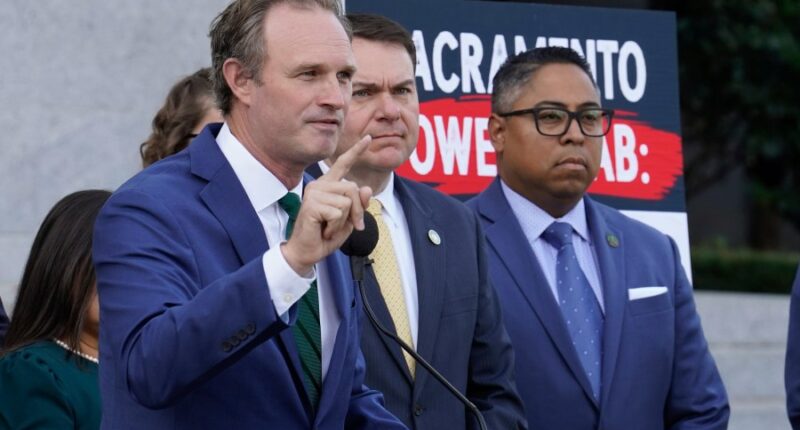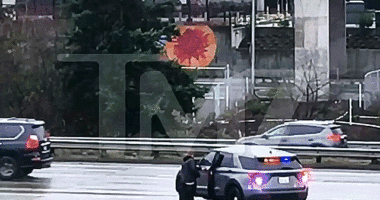Share this @internewscast.com

SACRAMENTO, Calif (AP) — In November, California voters will deliberate on a newly redrawn congressional map intended to aid Democrats in securing five additional U.S. House seats next year. This development follows Texas Republicans progressing with their revised map designed to bolster their House majority by an equal number of seats at the behest of President Donald Trump.
On Thursday, California lawmakers mostly voted along party lines to pass legislation that calls for the special election. Democratic Governor Gavin Newsom, who has championed the map’s cause, swiftly signed the measure, marking the latest move in the ongoing gerrymandering struggle between parties.
“We didn’t seek this confrontation, but with our democracy at stake, we will stand firm,” declared Democratic Assemblyman Marc Berman.
Republicans, who have filed a lawsuit and called for a federal investigation into the plan, promised to keep fighting it.
Assemblyman James Gallagher, the Republican minority leader, argued that while Trump might have been “wrong” to pursue additional Republican seats, it was a reaction to Democratic gerrymandering efforts. Nonetheless, he cautioned that Governor Newsom’s “fight fire with fire” strategy posed significant risks.
“You move forward fighting fire with fire and what happens?” Gallagher asked. “You burn it all down.”
In Texas, the state Senate, under Republican control, planned a vote on a map Thursday night. With Republican Governor Greg Abbott’s endorsement, the map would become official. This initiative is part of Trump’s broader strategy to counter a projected GOP majority loss in the U.S. House during the 2026 midterm elections.
A battle for the US House control waged via redistricting
Nationwide, the current district composition positions Democrats within three seats of reclaiming a majority. Historically, the party of the sitting president tends to lose congressional seats during midterm elections.
The president has pushed other Republican-controlled states including Indiana and Missouri to also revise their maps to add more winnable GOP seats. Ohio Republicans were also already scheduled to revise their maps to make them more partisan.
The U.S. Supreme Court has said the Constitution does not outlaw partisan gerrymandering, only using race to redraw district lines. Texas Republicans embraced that when their House of Representatives passed its revision Wednesday.
“The underlying goal of this plan is straight forward: improve Republican political performance,” state Rep. Todd Hunter, the Republican who wrote the bill revising Texas’ maps, said.
On Thursday, California Democrats noted Hunter’s comments and said they had to take extreme steps to counter the Republican move. “What do we do, just sit back and do nothing? Or do we fight back?” Democratic state Sen. Lena Gonzalez said. “This is how we fight back and protect our democracy.”
Democrats have sought a national commission for redistricting
Republicans and some Democrats championed the 2008 ballot measure that established California’s nonpartisan redistricting commission, along with the 2010 one that extended its role to drawing congressional maps.
Democrats have sought a national commission that would draw lines for all states but have been unable to pass legislation creating that system.
Trump’s midterm redistricting ploy has shifted Democrats.
That was clear in California, where Newsom was one of the members of his party who backed the initial redistricting commission ballot measures, and where Assemblyman Joshua Lowenthal, whose father, Rep. Alan Lowenthal, was another Democratic champion of a nonpartisan commission, presided over the state Assembly’s passage of the redistricting package.
Newsom on Thursday contended his state was still setting a model.
“We’ll be the first state in U.S. history, in the most democratic way, to submit to the people of our state the ability to determine their own maps,” Newsom said before signing the legislation.
Former President Barack Obama, who’s also backed a nationwide nonpartisan approach, has also backed Newsom’s bid to redraw the California map, saying it was a necessary step to stave off the GOP’s Texas move.
“I think that approach is a smart, measured approach,” Obama said Tuesday during a fundraiser for the Democratic Party’s main redistricting arm, noting that California voters will still have the final say on the map.
California’s plan is temporary
The California map would last only through 2030, after which the state’s commission would draw up a new map for the normal, once-a-decade redistricting to adjust district lines after the decennial U.S. Census. Democrats are also mulling reopening Maryland’s and New York’s maps for mid-decade redraws.
However, more Democratic-run states have commission systems like California’s or other redistricting limits than Republican ones do, leaving the GOP with a freer hand to swiftly redraw maps. New York, for example, can’t draw new maps until 2028, and even then, only with voter approval.
In Texas, outnumbered Democrats turned to unusual steps to try to delay passage, leaving the state to delay a vote by 15 days. Upon their return, they were assigned round-the-clock police monitoring.
California Republicans didn’t take such dramatic steps but complained bitterly about Democrats muscling the package through the Statehouse and harming what GOP State Sen. Tony Strickland called the state’s “gold-standard” nonpartisan approach.
“What you’re striving for is predetermined elections,” Strickland said. “You’re taking the voice away from Californians.”
___
The story has been updated to correct that the partisan makeup of existing districts puts Democrats within three seats of a majority, instead of that Republicans control the U.S. House by three votes. The first name of the Republican minority leader in the California Assembly has been corrected to James, instead of Mike.
——
Riccardi reported from Denver. Associated Press reporter Jim Vertuno in Austin, Texas, also contributed.
















